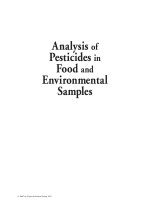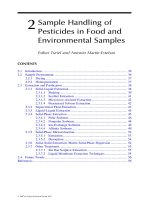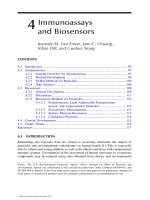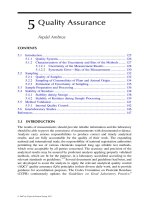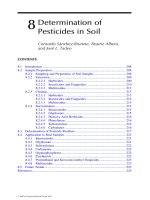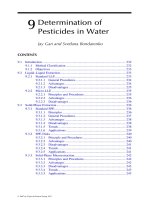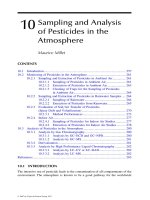Conservation and analysis of the physicochemical parameters of a congo food plant alicamentary [Pteridium aquilinum (L.) Kuhn]
Bạn đang xem bản rút gọn của tài liệu. Xem và tải ngay bản đầy đủ của tài liệu tại đây (433.7 KB, 10 trang )
Int.J.Curr.Microbiol.App.Sci (2019) 8(9): 247-256
International Journal of Current Microbiology and Applied Sciences
ISSN: 2319-7706 Volume 8 Number 09 (2019)
Journal homepage:
Original Research Article
/>
Conservation and analysis of the physicochemical parameters of a Congo
food plant alicamentary [Pteridium aquilinum (L.) Kuhn]
Arnaud W.G. Tamba Sompila1,2,3*, J. E. Moussounga1,2,3, A.B. Madiélé Mabika1,6,
N.P.G Pambou-Tobi1,2,3, P. Diakabana1,4,5, B.D.E. Miakayizila3,
M. Dzondo-Gadet1,2,3,4 and T. Silou4,5
1
Centre de Recherche et d’Initiation des Projets de Technologie, cité scientifique,
route de l’auberge de Gascogne, Brazzaville, R. Congo
2
Laboratoire de Bioprocédés alimentaires et médicaux,
ENSP-UMNG, BP. 69 Brazzaville, R. Congo
3
Ecole Nationale Supérieure Polytechnique, Université Marien NGOUABI, Brazzaville
4
EPRAN-Congo, Pôle d’Excellence en Alimentation et Nutrition, Faculté des Sciences et
Techniques, Université Marien NGOUABI, Brazzaville
5
Ecole Supérieure de Technologie des Cataractes, Brazzaville
6
Unité de Chimie du Végétal et de la Vie, FST-UMNG, BP. 69 Brazzaville, R. Congo
*Corresponding author
ABSTRACT
Keywords
Conservation,
Analysis,
Physicochemical
parameters, Food
plant, Pteridium
aquilinum
Article Info
Accepted:
15 August 2019
Available Online:
10 September 2019
In order to contribute to the valorization of non-timber products from the Congo, the aim
of the study was to contribute to the nutritional value of P. aquilinum fern. The harvested
fern plants were previously dried by solar drying for up to 4 hours and finally crushed to
obtain a powder after sieving. This powder made it possible to study the biochemical and
physicochemical characteristics of fronds. The results of the biochemical analysis revealed
moisture contents of 13.87 ± 0.17%; the ash content of 9.25 ± 0.49%; lipid content 7.07 ±
0.41%, and that of soluble sugars 0.54 ± 0.021. Meanwhile, the protein and total
carbohydrate contents are relatively high, respectively 20.33 ± 0.58% and 49.51 ± 0.2%.
The physicochemical analysis, based on the measurement of the chemical indices, showed
that only the peroxide index complies with the STAN 210-1999 Codex standards. In
addition, the other two indices do not comply with the standards of the CODEX STAN
210-1999 standard, i.e., 256.25 mg of KOH / g of saponification oil, 14.03 ± 1.5% of oleic
acid for the acid number and the peroxide value 8.6 ± 1.75 meq O 2/kg of oil.
Introduction
Looking back, we find that man lived in
harmony with his environment. He knew how
to take advantage of the great wealth of fauna
and flora to obtain a balanced diet, with regard
to proteins, vitamins and mineral salts
(Mbemba and Remacle, 1992).
247
Int.J.Curr.Microbiol.App.Sci (2019) 8(9): 247-256
In developing countries, undernutrition and
child malnutrition are major problems often
recorded in public health.
Materials and Methods
In addition, Congo has a significant diversity
of food tree species that are sometimes poorly
exploited. Many of these species contribute
significantly to the equilibrium of rural food
rations. Indeed, various edible parts of the
plants
are
used
directly
or
after
transformation. These include asparagus,
matembele (leaves of Hypomea batatas), and
ferns. Taking into account the ferns, in the
Congo, we have a number that are almost
completely edible, including the bracken fern.
The young fronds of the fern were used as
vegetable raw material (Figure 1).
In certain localities of the Congo, this bracken
fern is called in vernacular language by
makoungou or fesi; The bracken fern is known
under the scientific name: P. aquilinum (L)
Kunh is a fern belonging to the family
Dennstaedtiaceae. There are two subspecies
identified to date, which are aquilinum and
caudatum (Thomson, 2000).
Plant material
Drying equipment
A boat-type solar dryer designed at CRIPT
was used to dry the young fronds of P.
aquilinum with the following characteristics:
6.0 m long, 1.60 m wide and 1.05 m high,
with a sheet absorber arranged over a length of
2 m and a width of 1.60 m in the form of a
0.60 m2 surface partition on the roof of the
dryer. It has a wide aeration zone of 0.4 m and
at least 1.60 m long located at the end of the
surface of the catchment area.
This dryer has a capacity of more than 10 kg
of products to dry (Figure 2).
Methods
Fern is a crop of young processed fronds that
are used as human food in some parts of the
world, although there are reports of its toxic
effects on livestock (Fenwick GR, 2006,
Yamada K, et al., 2007, Madeja, J, et al.,
2009).
In traditional medicine, its analgesic,
antibacterial and antiparasitic properties have
been reported (Hassan SW, et al., 2007, Swain
T, 1974). In addition, its decoction is orally
taken as a remedy for malarial fever
disturbances (Nwiloh Barine Innocent et al.,
2014).
The purpose of this study is to value while
keeping the bracken fern considered as a
vegetable, but unfortunately little known to
the Congolese population by making a
nutritional contribution.
Collection
material
and
identification
of
plant
The whole plant of P. aquilinum was
harvested in the department of Brazzaville
precisely in the northern districts of
Brazzaville. But only young fresh fronds were
used. The harvest took place in August 2017
and this plant was identified at the level of the
national herbarium at the Institute of Research
in Exact and Natural Science (IRSEN).
Sample preparation and drying kinetics
After separating the young fronds from the
rest of the plant (the rhizome), they were
washed with tap water to rid them of certain
impurities. Once washed, they are drained to
remove as much water as possible before
being placed in the solar dryer.
248
Int.J.Curr.Microbiol.App.Sci (2019) 8(9): 247-256
The young fronds are arranged in the dryer in
order to facilitate the almost total elimination
of the water. These fronds were dried for 4
hours following a kinetic while noting the
variations of drying temperature and humidity
of the air in the dryer.
When the samples are completely dry, they are
first milled using an electric grinder (Bruders
type Bl-133), and then a fine powder is
obtained after sieving.
Drying kinetics
The drying kinetics made it possible to carry
out weighing every 30 min, at the same time
measurements of the temperature and that of
the humidity of the air in the dryer during
drying. The brand Thermo-anemometer
Lafayette A-M-Flex was used as a device to
collect the temperature and humidity of the air
in the dryer.
This kinetics made it possible to determine the
dry basis water contents and the rate of drying
of the sample by the following formulas:
Moisture content
The water content was determined according
to the (official) AOAC method, 1997 where
two (2) grams of powder were placed in the
oven at 103 ± 2 ° C for 24 hours. The
measurement is stopped until the dry residue
is of constant weight;
Ash content
The amount of ash has also been determined
by standard methods (Pomeraz and Meloan,
1994). 2 g of the dry matter were weighed into
the porcelain crucibles which were placed in
the muffle furnace at a temperature of 550 ° C
for 8 hours until a white residue of constant
weight was obtained;
Soluble carbohydrates
Soluble carbohydrates were determined by the
method of (Yemme, 1954).
Total carbohydrates
The total carbohydrates were obtained by
simple difference according to the following
formula (Manzi et al., 2004):
(1)
Carbohydrates= 100 – [lipids + proteins +
water + Ash] (3)
(2)
Chemical and biochemical analysis
Lipid extraction
Chemical composition
The chemical composition of the fine powder
of P. aquilinum was evaluated in terms of
protein, water (moisture), ash, soluble
carbohydrate, total fat and lipid contents.
Crude protein content
Proteins were determined by the common
method of (Glowa, 1974) using microKjeldahl;
15 g of P. aquilinum was used to extract the
oil using 100 ml of n-hexane in a soxhlet
extractor (Moulinex SeBPREP'LINE model
850) at 60 ° C for 6 h, as described in the
standard method ( AOAC, 1997). The solvent
was evaporated at 50 ° C under reduced
pressure using a rotary evaporator (N-1 model,
Eyela, Tokyo Rikakikal Co., Ltd. Japan).
The oil was recovered, placed in a flask and
placed under nitrogen until complete removal
of the solvent.
249
Int.J.Curr.Microbiol.App.Sci (2019) 8(9): 247-256
Analysis of physicochemical indices
The chemical analysis of the oil was evaluated
by measuring the chemical indices. These
indices were determined according to known
standard methods: The acid number according
to standard method 969.1 (AOAC, 2012); the
saponification number according to the
standard method 965.33 (AOAC, 12) and the
peroxide content according to the standard
method 920.160 (AOAC, 2012).
Evaluation of the oil indices of P. aquilinum
The indices of oils are usually determined
according to the standard methods: the acid
number [AOAC (12), the standard method
969.1], the iodine content [AOAC (12),
standard
method
993.20),
and
the
saponification value [AOAC Standard Method
965.33 (12)] and peroxide content [AOAC
Standard Method 920.160 (12)].
Statistical analysis of the data
All experiments, measurements and analyses
were performed three times, and the results
presented are the average values of three
replicates. Curves and coefficients of
determination (R2) were obtained using the
Microsoft Excel 2010 software. Significance
was defined at P <0.05.
The kinetics of drying achieved, resulted in
the plots of the curves appearing on the plot
presented above. Figure 3 shows the variation
curves of product mass, temperature and air
humidity in the dryer as a function of time.
The temperature curve shows an evolution that
exponentially increases until reaching its
maximum peak at 41.7 ° C after 210 min in
the dryer.
As shown in Figure 3, the mass of the sample
decreases significantly with increasing drying
temperature. The curve of the mass can be
described in 3 phases: an initial phase of 0 to
60 min where one observes a sudden and fast
fall of mass (28.17 to 23.09 g). This
significant loss may be due to the removal of
water on the surface of the product. Several
researchers have reported similar work in
different food matrices (Ridene et al., 2006;
Arlabosse, 2008). An intermediate phase
between 90 and 270 min where there is a
gradual and extensive decrease in mass. A
third phase where a very slow and progressive
mass loss is observed until stabilization after
360 min.
The curve of the relative humidity as a
function of time shows a progressive
decreasing pace, until stabilizing from 180
min. This curve is the reverse of the
temperature curve (Figure 3a).
Results and Discussion
Drying kinetics
The result on the kinetics of drying is shown
in Figure 3, which shows the loss of mass, the
temperature inside the dryer and that of the
relative humidity as a function of time.
Most food products contain high amounts of
water, which is partially or completely
removed during dehydration. Drying food
matrices involves both internal and external
processes of heat and mass transfer.
Figure 3a shows the dry basis water content or
the amount of water evaporated as a function
of time. This curve confirms that of mass loss.
There was a rapid loss of water during the first
90 minutes. Between 90 and 270 min, there is
a slow loss of water that evolves gradually and
tends to stabilize just after 270 min.
Subsequently, we evaluated the rate of drying
of the product by the formula (2) that we
presented previously. This is determined in
terms of time.
250
Int.J.Curr.Microbiol.App.Sci (2019) 8(9): 247-256
The drying speed is given in Figure 3b below.
The drying rate of P. aquilinum powder
samples were evaluated by calculation
according to formula 2. This speed is
determined in terms of time.
Figure 4 shows the curve of variation of the
drying speed. The latter is the speed of the air
inside the dryer which depends on the speed of
the ambient air outside the dryer. The speed
curve shown in Figure 4, corresponds to the
speed of water loss of the product inside the
dryer. It can be seen that the initial value of
the speed is very low, especially since there is
no renewed air circulation. This low speed
justifies the way of circulation or convection
of air which is done naturally. The rate of
water loss gradually decreases to around 210240 min.
Chemical composition
The chemical composition of P. aquilinum
powder is summarized in Table 1. This shows
that the powder contains approximately 7.07 ±
0.41% oil content, 9.25 ± 0.49% ash content
and 13.87 ± 0.17% ash content. water content.
It is also noted that the total protein and
carbohydrate levels of the slings are relatively
high (20.33 ± 0.58% and 58.89 ± 0.2%
respectively).
Soluble carbohydrates determined gave 0.54 ±
0.021%. This low soluble sugar content
reveals that the fern fronds contain very little
reducing sugars and that the other sugars are
involved in the saccharide bonds.
We were led to verify all the sugars in this
plant by performing a calculation formula 3.
Awe, S and Amobi, O., (2015) also studied the
chemical composition of P. aquilinum fronds.
Their work reports a slightly high protein
content (21.90%), while the ash, water and
lipid contents are relatively lower than those
obtained in our work. This can be explained
by the source of P. aquilinum fronds where
geographical factors may have an influence.
Table.1 Biochemical composition of fronds of P. aquilinum
Composition
Moisture
Ash
Lipid
Young fronds of P. aquilinum (%)
13.87±0.17
9.25±0.49
7.07±0.41
20.33±0.58
58.89±0.2
0.54 ± 0.021
Proteins (Ntx6.25)
Carbohydrates
Carbohydrates Soluble
Table.2 Oil index of different seeds
Indices
Peroxide Values (Pv)
Acidity (Oleic)
Saponification Values (Sv)
Young fronds of P. aquilinum (%)
8.6±0.75
14.03±1.5
256.25±6.2
251
Int.J.Curr.Microbiol.App.Sci (2019) 8(9): 247-256
Figure.1
Figure.2
Figure.3
252
Int.J.Curr.Microbiol.App.Sci (2019) 8(9): 247-256
Figure.3a
Figure.3b
Figure.4
Physico-chemical indices
In agreement with the literature, the acid
number can be considered as an indicator of
hydrolytic deterioration (Yaghmur et al.,
2001) of fat caused by a combination of
The acid number (Ia), the peroxide content
(Ip) and the value of the saponification
number (Is) are shown in Table 2.
253
Int.J.Curr.Microbiol.App.Sci (2019) 8(9): 247-256
enzymes and moisture (Gan et al., 2005 ) but
it can also be related to their quality.
Regarding soluble sugars, the respective
concentrations found in solutions S1, S2, S3
are: 0.56 mg / ml, 0.52 mg / ml, 0.54 mg / ml.
Taking into account the dilution factor and the
concentrations obtained was possible to
calculate the carbohydrate masses. These
masses were used to determine the
percentages of soluble carbohydrates, which
gave an average value of 0.54% ± 0.021
(Table 1).
When the acid value content of the oil
exceeds the objectionable quantity, it must be
discarded (AB Bhattacharya et al., 2008)
because a high acidity is not acceptable in any
consumable and commercial product due to
the bad taste caused by the degradation
products
(volatile
and
non-volatile
compounds) of free fatty acids (Yaghmur et
al., 2001) during a treatment. The standards
of CODEX STAN 210-1999, stipulate for
unconventional oils, values of acid number is
4.0 mg KOH / g of oil. In this study, the acid
value of P. aquilinum (Ia) oil obtained is
14.03 ± 1.5. This value reveals a high acidity
of the oil studied, which excludes it for a
human diet.
In conclusion, the fronds of P. aquilinum have
a good nutritional value according to the
chemical composition determined. The
protein content (20.33 ± 0.58%) is very
important that this vegetable deserves to be
consumed and valorized in terms of the
toxicity that can be eliminated by cooking.
The ash content (9.25 ± 0.49%) reveals that
the fronds of the fern contain a certain amount
of minerals. The oil of P. aquilinum is solid at
room temperature. It is dark green in color.
According to Bensmira et al., 2007, peroxide
formation is an important concern from the
point of view of rancidity and toxicology, and
are also considered to be good guides to oil
quality (H.L. Gan et al., 2005). For this
reason, some authors report that the extent of
oil oxidation is frequently assessed by
measuring peroxide levels (Melton et al.,
1994, Yaghmur et al., 2001). The results
obtained from the peroxide index (Ip) give the
average value of 8.6 ± 1.75 meq O2 / kg of oil.
In fact, the value obtained is higher than the
limit value recommended for a food oil by
CODEX STAN 210-1999 which is 15 meq O2
/ kg of oil. The value of this index indicates
that the oil of P. aquilinum fronds studied
does not oxidize easily, as it must probably be
rich in saturated fatty acids. At room
temperature, this oil is solid.
The fronds of P. aquilinum contain a low
content of soluble sugars (0.54 ± 0.02%). The
total carbohydrates (49.48 ± 0.2%) contained
in P. aquilinum fronds make this vegetable a
good source of protein and energy.
References
Atanu B. Bhattacharya, M. G. Sajilata, Sudha
R. Tiwari, Rekha S. Singhal, 2008.
Regeneration of thermally polymerized
frying oils with adsorbents, Food
Chemistry 110, 562–570
AOAC, 1997. Official methods and
recommended pratics of the American
Oil Chemists Society (5th ed.).
Champaign, USA: AOCS Press.
Awe, S and Amobi, O.O, 2015. Antibacterial,
Phytochemical and Proximate Analysis
of Pteridium aquilinum, International
Journal of Research in Pharmacy and
Biosciences, (2), pp 1-7.
A. Yaghmur, A. Aserin, Y. Mizrahi, A. Nerd
As regards the saponification number, the
value of 256.25 mg KOH / g of oil does not
comply with CODEX STAN 210-1999
standards, the standard of which is between
189.7 and 195.2 mg KOH / 100g d 'oil. This
oil can be used in cosmetics or soap.
254
Int.J.Curr.Microbiol.App.Sci (2019) 8(9): 247-256
and N. Garti, 2001. Evaluation of Argan
Oil for Deep-Fat Frying; Lebensm.Wiss. u.-Technol., 34, 124 - 130
Codex
Alimentarius,
1999.
Codex
Alimentarius standards for fats and oils
from vegetable sources 2. Codex
Alimentarius standards for named
vegetable oil. Codex Alimentarius Stan
210.
Fenwick. G. R, 2006. Bracken (Pteridium
aquilinum) toxic effects and toxic
constituents. J. sci. food. Agric. 6: 147173.
Glowa. W, 1974. Zircomuim dioxide, a new
catalyst in the KJELDAHL method for
total N determination. J. Assoc. Anal.
Chem., 57, 1228-1230.
Hassan. S. W, Umar R. A, Dabai Yu, Ebbo
A. A, Faruk U. Z, 2007. Antibacterial,
phytochemical and Toxicity studies of
Pteridium
aquilinum
L.
(Dennestaedtiaceae) in rabbits. J.
Pharmacol. Toxicol. 2: 168–175
Gan, H. L., Y. B. Che Man, C. P. Tan, I.
NorAini, S. A. H. Nazimah, 2005.
Characterisation of vegetable oils by
surface acoustic wave sensing electronic
nose. Food Chemistry 89, 507–518
Madeja. J, Harmata. K, Kolaczek. P,
Karprinska-Kolaczek. M, Platek. K,
Naks, P, 2009. Bracken (Pteridium
aquilinum L. Kuhn), Mistletoe (Viscum
album L.), and bladdernut (Staphylea
pinnata L.). Mysterious plants with
unusual applications. Cultural and
ethnobotanical studies. Plants and
culture: seeds of the cultural; heritage of
Europe.
Edipulgia.
S.r.l.
www.edipulgia.it.
Melton. S. L, Jafar. S, Sykes. D and Trigiano,
M. K, 1994. Review of stability
measurements for frying oils and fried
food flavor. Journal of the American
Oil Chemists 1 Society, 71, 1301 -1308
Meriem Bensmira , Bo Jiang, Consolate
Nsabimana, Tang Jian, 2007. Eff ect of
Lavender and Thyme incorporation in
sunflower seed oil on its resistance to
frying temperatures, Food Research
International 40, 341–346
Mbemba. F et Remacle. J, 1992, Inventaire et
composition chimique des aliments et
denrées alimentaires traditionnels du
Kwango-Kwilu au Zaïre. Presses
universitaires de Namur, Namur, p : 80.
Nwiloh Barine Innocent, Uwakwe Augustine,
Monago Comfort, 2014. In vivo
antimalarial activity of methanolic
extract of young fronds of Pteridium
aquilinum L. kuhn in mice infected with
Plasmodium berghei. Journal of
pharmacology Online, vol.1, 114-120.
Pearson. D, 1976. General Methods in the
Chemical Analysis of Food London.
Longman Group Ltd. London, pp: 6-26.
Pieroni. A, Quave C. L, 2005. Traditional
pharmacopoeias and medicines among
Albanians and Italians in Southern
Italy:a comparison. J. Ethnopharmacol
101:258 – 270.
Pomeraz. Y and C. Meloan, 1994. Food
Analysis: Theory and Practice. 3rd
Edn., Chapman and Hall, New York,
pp: 778.
Swain. T, 1974. Biochemical evolution in
plants. In comprehensive Biochemistry,
29 part A, comparative biochemistry,
Molecular evolution, Florkin M, Stotz
EH (Eds). Elsevier, Amsterdam.
Thomson J.A, 2000. Morphological and
genomic diversity in the genus
Pteridium
(Dennstaedtiaceae).
—
Annals of Botany, vol. 85, pp. 77-99.
Yamada. K, Ojika. M, Kigoshi. H, 2007.
Ptaquiloside, the major toxin of
bracken, and related terpene glycosides:
chemistry, biology and ecology. Nat.
prod. Rep., 24:798 –813.
Yemm. E. W, Willis. A. J, 1954. The
estimation of carbohydrates in plant
extracts by anthrone. Biochem.J. 57,
508-514.
255
Int.J.Curr.Microbiol.App.Sci (2019) 8(9): 247-256
Manzi. P, Marconi. S, Aguzzi. A and L.
Pizzoferrato,
2004.
Commercial
mushrooms: nutritional quality and
effect of cooking. Food Chemistry, 84:
201-206.
Ridene. H, Azzouz. S, Ghorbel. D, 2006.
Séchage des tomates par l'air chaud :
Cinétique et qualité.1er Séminaire
Maghrébin sur les Sciences et
Technologies de séchage.
Arlabosse, P. 2008. Séchage industriel.
Aspects pratiques. Techniques de
l’Ingénieur, J. 2455:1–24.
How to cite this article:
Arnaud, W.G. Tamba Sompila, J.E. Moussounga, A.B. Madiélé Mabika, N.P.G. PambouTobi1, P. Diakabana, B.D.E. Miakayizila, M. Dzondo-Gadet and Silou, T. 2019. Conservation
and Analysis of the Physicochemical Parameters of a Congo Food Plant Alicamentary
[Pteridium aquilinum (L.) Kuhn]. Int.J.Curr.Microbiol.App.Sci. 8(09): 247-256.
doi: />
256



